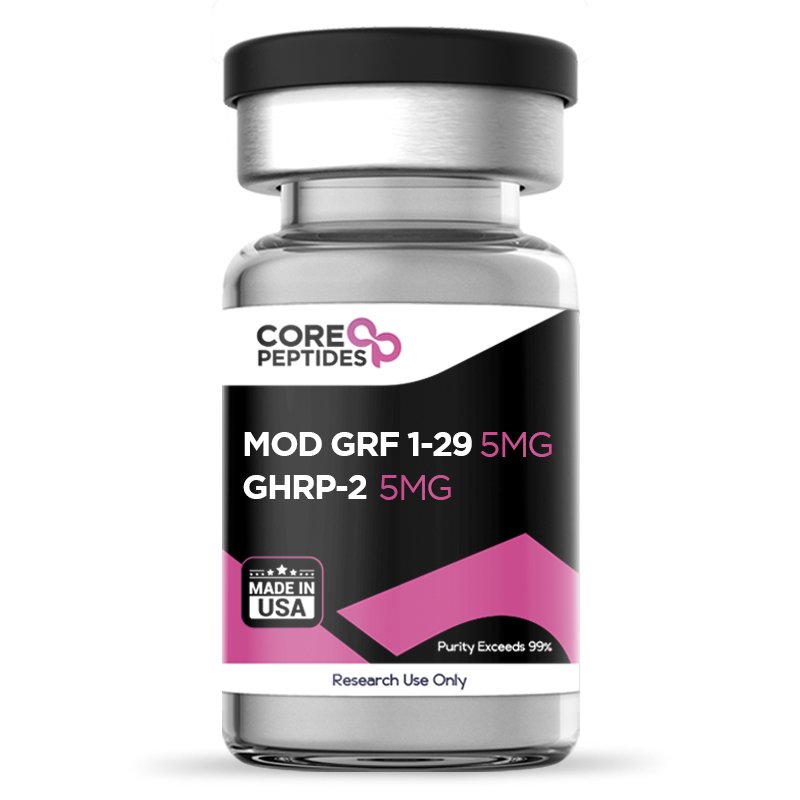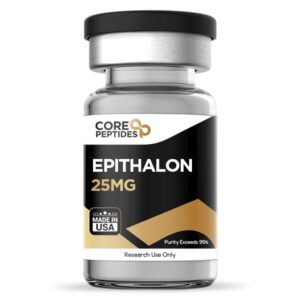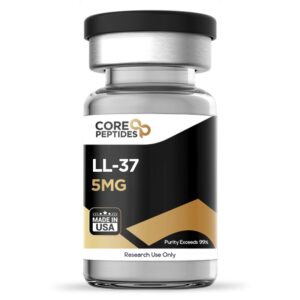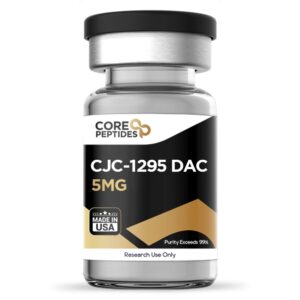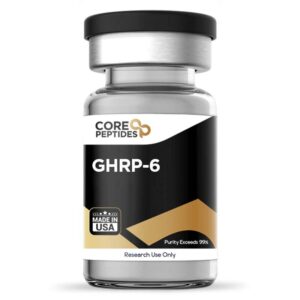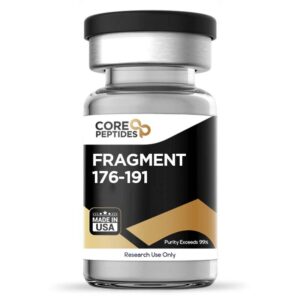Mod GRF 1-29 & GHRP-2 Blend (10mg)
$73.00
Size: 10mg
Contents: Mod GRF 1-29 (5mg) & GHRP-2 (5mg)
Form: Lyophilized powder
Purity: >99%
SKU: P-MODGRFGHR2-10
FREE Shipping on $200+ orders
Discount per Quantity
| Quantity | Discount | Price |
|---|---|---|
| 5 - 8 | 5% | $69.35 |
| 9 + | 10% | $65.70 |
Mod GRF 1-29 & GHRP-2 Peptide Blend
GHRP-2 and Modified GRF 1-29 peptides are synthetic peptides developed with the intention to aid in synthesis, secretion, and regulation of growth hormone synthesis. These peptides appear to exert synergistic action when taken together as a blend.
GHRP-2 is a synthetic peptide that apparently activates the receptors for ghrelin.(1) Ghrelin is a naturally occurring peptide containing 28 amino acids that is considered by scientists to regulate growth hormones, and increase appetite.(2) This is why it is also referred to as ‘the hunger hormone.’ GHRP-2 appears to activate the ghrelin receptors in the pituitary gland, which are also called growth hormone secretagogue receptors, and thus may potentially stimulate growth hormone release. Thus, GHRP-2 has been characterized by researchers as a growth hormone secretagogue (GHS).
Modified GRF 1-29 (or Mod GRF 1-29) is a man-made peptide analog to the naturally occurring growth hormone-releasing hormones (GHRH). It is made of the first 29 amino acids of the native hormone, which appears sufficient for activating the GHRH receptors in the somatotroph cells in the anterior pituitary gland and triggering growth hormone release. Structurally similar to GRF 1-29, the peptide contains a chain of 29 amino acids and is slightly modified for proposed durability by substituting four of the amino acids in the original amino acid-chain.(3) These modifications appear to enhance the pharmacokinetics of the peptide.
GHRP-2 and Mod GRF 1-29 have been studied for their individual potential to stimulate the somatotroph cells in the pituitary gland, possibly triggering the secretion of growth hormone.(4)
Chemical Makeup (3)(5)
Molecular formula:
- Modified GRF 1-29: C152H252N44O42
- GHRP-2: C45H55N9O6
Molecular weight:
- Modified GRF 1-29: 3367.9 g/mol
- GHRP-2: 817.9 g/mol
Other known titles:
- Modified GRF 1-29: Mod GRF 1-29, CJC-1295 without DAC
- GHRP-2: Pralmorelin, Growth hormone-releasing peptide-2
Research and Clinical Studies
Modified GRF 1-29 & GHRP-2 Peptide Blend and Tolerability
Research studies in animal models(5) have conducted to understand the various potential actions of GHSs such as GHRP-2. According to researchers, the presentation of the peptides in both guinea pigs and rabbits did not result in any serious or profound action on the tested experimental models. The only reported change was seen was an increase in the motility rate of the isolated ileum of rabbits and increased muscle contractions in the isolated ileum of the guinea pigs. No other impacts were observed on the kidneys, respiratory, gastric, and blood systems. As per Furuta S et al., these results suggest that the peptide “has no serious general pharmacological effects at dose levels showing GH-releasing activity in the experimental animals. Therefore, it is concluded that the peptide [may be useful in] diagnosing serious GH deficiency and treating short stature.” (5)
Modified GRF 1-29 & GHRP-2 Peptide Blend and Appetite
Due to its potential to activate the ghrelin receptors not just in the pituitary gland but also in other areas, GHRP-2 is considered the likely compound for inducing hunger and appetite increase in this peptide blend. A clinical trial(6) was carried out in which seven test subjects were observed. The subjects in the trial were divided into two groups – one experimental peptide group and a placebo (saline) group receiving each of the compounds for approximately 5 hours. After peptide presentation, all subjects were taken to buffet-style meals to measure their food intake. The peptide group were reported to have consumed approximately 35% more food measured in kilocalories than the saline group, with each subject exhibiting increased appetite when measured against their body weight. Moreover, the concentration of growth hormone also appeared to increase significantly in the peptide test subjects. These results indicate a possibility that one of the additional actions of the peptide blend may be increased food intake and appetite, particularly due to the presence of GHRP-2.
General Research in Growth Hormone Secretagogues (GSHs), Growth Hormone Releasing Peptides (GHRPs)
A literature review(7) aimed to evaluate the potential impacts of growth hormone secretagogues (GSHs) such as GHRP-2. As part of some of the studies included in the review, subjects were monitored for physiological changes after being presented with the peptide. The results suggested that these peptides appeared to yield an increased growth rate in younger subjects, with increased appetite, and increased lean mass in mature subjects. In obese test subjects, these peptides appeared to stimulate a reduction in bone turnover, increased lean mass, and improved sleep cycle. The researchers stated that these peptides appear to “increase lean body mass, reduce fat mass, increase exercise tolerance and maximum oxygen uptake, enhance muscle strength, and improve linear growth.”(7)
Modified GRF 1-29 & GHRP-2 Peptide Blend and Growth Hormone Deficiency
Since 2000, several clinical studies have been conducted on test models of growth hormone deficiency. Models presented with the GHRP-2 peptide stimulating growth hormone release indicated that this peptide might produce action in two ways, including (i) possibly stimulating the pituitary gland to release growth hormones and (ii) acting on the arcuate nucleus of the hypothalamus. While GHRP-2 appears to yield high concentrations of growth hormone, it remains to be seen how its action is exerted. In addition, these studies suggested that these peptides may impact food intake and sleep cycle via receptor-specific agonist actions.(8)
In another GHRP-2 study focusing on young test subjects, six growth hormone-deficient subjects facing growth failure were presented with different concentrations of the peptide for eight months.(9) All subjects were monitored for any significant rise in growth hormone levels and toxicity levels during this period. Throughout the study, there appeared to be a steep rise in the levels of growth hormones in all subjects for the duration of the study and a little time after. As per V Mericq et al., the study suggested that the peptide was “well tolerated and [may] stimulate GH secretion.”
Modified GRF 1-29 & GHRP-2 Peptide Blend and Hormones
In one clinical study,(10) the primary objective was to understand the impact of GHRP-2 presentation on growth hormones, cortisol, prolactin, and adrenocorticotropic hormone (ACTH) levels in male test subjects. All subjects were divided into two groups based on their age – the first group had six mature subjects aged between 22 and 27 years, and the second group had 6 mature subjects aged between 66 and 73 years. Both groups were presented with GHRP-2. While the growth hormone levels increased in both groups, the younger group was observed to have a significant increase compared to the elderly subjects. It also appeared to stimulate increased levels of ACTH and cortisol hormones and a mild increase in prolactin levels. The results supported the hypothesis that the peptide may have profound hormonal secretion capabilities in both mature and young male test subjects.
Modified GRF 1-29 & GHRP-2 Peptide Blend and the GHRH receptors
While GHRP-2 appears to function by binding to the GHS-R1a receptor, often referred to as the growth hormone secretagogue receptor type 1a, Mod GRF 1-29 appears to promote growth hormone release by potentially engaging with the GHRH receptors located on the somatrophs of the anterior pituitary gland. Upon binding to these receptors, Mod 1-29 appears to potentially trigger a series of intracellular signals. A notable pathway that gets activated is the adenylyl cyclase pathway, which might lead to the transformation of ATP (adenosine triphosphate) into cAMP (cyclic adenosine monophosphate). The subsequent increase in cAMP levels seems to stimulate protein kinase A (PKA), possibly resulting in the phosphorylation of specific proteins, such as the voltage-dependent calcium channels on the cellular membrane. The opening of these channels might allow calcium ions to flow into the somatotropic cells. This surge in intracellular calcium seems to encourage the secretory vesicles within these cells to discharge growth hormone into the bloodstream. Researchers have suggested that Mod GRF 1-29, through these cellular processes, may aid in the release and production of growth hormone upon interaction with GHRH receptors.
Modified GRF 1-29 & GHRP-2 Peptide Blend and the Insulin-like Growth Factor-1 (IGF-1)
A comprehensive review of the literature suggests that both the GHRH-mimetics like Mod GRF-1 and the GHS GHRP-2 may upregulate growth hormone levels and consecutively its main anabolic mediator IGF-1. The researchers comment that the unmodified version of Mod GRF-1 may apparently boost mean growth hormone levels by 82% in research conditions, as indicated by area under the curve (AUC) measurements. The growth hormone concentrations appeared elevated for about two hours after the intervention.(11)
Other trials have also suggested a potential 64% increase in mean growth hormone levels as measured by AUC, and the increase appeared greater in studies conducted in the evening, compared to those conducted in the morning. This apparent increase in growth hormone levels has also been suggested to occur in modified versions of GRF 1-29 which closely resemble Mod GRF-1 and have been posited to reach 70-107% increase in growth hormone levels measured by AUC. This potentially translates to a significant increase in IGF-1 levels of 27-28%.(11)
Another trial covered in the aforementioned review also suggested that the combination of unmodified Mod GRF 1-29 and GHSs like GHRP-2 might result in whopping 65% increase in IGF-1 levels.(11)
Modified GRF 1-29 & GHRP-2 Peptide Blend and Synergistic Potential
As mentioned, both Mod GRF 1-29 and GHRP-2 appear to stimulate the release of growth hormone. The available research suggests that GHRP-2 may lead to a 47-fold increase in pulsatile growth hormone secretion. Unfortunately, there is a lack of experiments revealing how much exactly Mod GRF 1-29 may upregulate growth hormone synthesis. Yet trials on another GHRH-mimetic, more specifically the non-truncated and unmodified version of Mod GRF 1-29 which has shorter half life, appear to lead to a 20-fold increase in pulsatile growth hormone secretion. It has been hypothesized that the combination of such GHRH-mimetics and the secretagogue GHRP-2 may potentially exhibit synergistic potential in regards to their apparent stimulation of growth hormone secretion. Notably, when combining GHRH and GHRP-2, the blend was observed to induce a 54-fold increase in pulsatile GH secretion compared to controls, suggesting a synergistic potential.(11)
Mod GRF 1-29 & GHRP-2 blend is available for research and laboratory purposes only. Please review and adhere to our Terms and Conditions before ordering.
References
- Garcia JM, Merriam GR, Kargi AY. Growth Hormone in Aging. [Updated 2019 Oct 7]. In: Feingold KR, Anawalt B, Boyce A, et al., editors. Endotext [Internet]. South Dartmouth (MA): MDText.com https://www.ncbi.nlm.nih.gov/books/NBK279163/
- Phung LT, Sasaki A, Lee HG, Vega RA, Matsunaga N, Hidaka S, Kuwayama H, Hidari H. Effects of the administration of growth hormone-releasing peptide-2 (GHRP-2) orally by gavage and in feed on growth hormone release in swine. Domest Anim Endocrinol. 2001 Jan;20(1):9-19. https://pubmed.ncbi.nlm.nih.gov/11164330/
- National Center for Biotechnology Information (2023). PubChem Compound Summary for CID 91976842, CJC1295 Without DAC. https://pubchem.ncbi.nlm.nih.gov/compound/CJC1295-Without-DAC.
- Roh SG, He ML, Matsunaga N, Hidaka S, Hidari H. Mechanisms of action of growth hormone-releasing peptide-2 in bovine pituitary cells. J Anim Sci. 1997 Oct;75(10):2744-8. doi: 10.2527/1997.75102744x. PMID: 9331879. https://pubmed.ncbi.nlm.nih.gov/9331879/
- Furuta S, Shimada O, Doi N, Ukai K, Nakagawa T, Watanabe J, Imaizumi M. General pharmacology of KP-102 (GHRP-2), a potent growth hormone-releasing peptide. Arzneimittelforschung. 2004;54(12):868-80. doi: 10.1055/s-0031-1297042. PMID: 15646371. https://pubmed.ncbi.nlm.nih.gov/15646371/
- Laferrère, Blandine et al. “Growth hormone releasing peptide-2 (GHRP-2), like ghrelin, increases food intake in healthy men.” The Journal of clinical endocrinology and metabolism vol. 90,2 (2005): 611-4. https://www.ncbi.nlm.nih.gov/pmc/articles/PMC2824650/
- Sigalos, John T, and Alexander W Pastuszak. “The Safety and Efficacy of Growth Hormone Secretagogues.” Sexual medicine reviews vol. 6,1 (2018): 45-53. doi:10.1016/j.sxmr.2017.02.004 https://www.ncbi.nlm.nih.gov/pmc/articles/PMC5632578/
- Rogério G. Gondo et al, Growth Hormone-Releasing Peptide-2 Stimulates GH Secretion in GH-Deficient Patients with Mutated GH-Releasing Hormone Receptor, The Journal of Clinical Endocrinology & Metabolism, Volume 86, Issue 7, 1 July 2001, Pages 3279–3283, https://doi.org/10.1210/jcem.86.7.7694.
- Mericq V, Cassorla F, Salazar T, Avila A, Iñiguez G, Bowers CY, Merriam GR. Effects of eight months treatment with graded doses of a growth hormone (GH)-releasing peptide in GH-deficient children. J Clin Endocrinol Metab. 1998 Jul;83(7):2355-60. https://pubmed.ncbi.nlm.nih.gov/9661608/
- Emanuela Arvat, Lidia Di Vito, Barbara Maccagno, Fabio Broglio, Muni F Boghen, Romano Deghenghi, Franco Camanni, Ezio Ghigo, Effects of GHRP-2 and Hexarelin, Two Synthetic GH-Releasing Peptides, on GH, Prolactin, ACTH and Cortisol Levels in Man. Comparison with the Effects of GHRH, TRH and hCRH, Peptides, Volume 18, Issue 6, 1997, Pages 885-891, ISSN 0196-9781, https://doi.org/10.1016/S0196-9781(97)00016-8
- Sinha, D. K., Balasubramanian, A., Tatem, A. J., Rivera-Mirabal, J., Yu, J., Kovac, J., Pastuszak, A. W., & Lipshultz, L. I. (2020). Beyond the androgen receptor: the role of growth hormone secretagogues in the modern management of body composition in hypogonadal males. Translational andrology and urology, 9(Suppl 2), S149–S159. https://doi.org/10.21037/tau.2019.11.30
